TACTICAL FOLDING KNIVES: A subjective view.
By Dennis Martin
In the beginning was the pocket knife. Beloved by generations of men and boys, this simple design saw countless uses in the camp, home, workplace or garden.
The simplest type of pocket knife is the pen-knife, which, in it's ultimate evolution is the Swiss Army Knife [SAK]. Useful as this knife can be, it has obvious drawbacks in a self-protection scenario. That non-locking blade can slam shut on your own fingers, not ideal in a fight! Although during WW-2 the great W.E. Fairbairn taught the "Jack-knife" technique to his students, using the military-issue clasp knife in a
gralloching action, this was intended as a last-ditch manoeuvre. For the most part, the penknife is unsuitable for the fight.
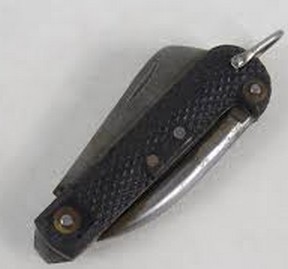 [British WW-2 Clasp knife]
[British WW-2 Clasp knife]Many modern pocket knives are lock-knives, with the blade positively locking open until released by a catch. Although much better, this still pre-supposes that you have arranged to have the knife in hand before trouble starts. Because many violent confrontations are surprise attacks, any good self-protection weapon needs to be accessible under stress. A pocket-knife is designed, obviously, to be carried within a pocket, or, a belt pouch. Hardly the easiest access option in a stressful situation. Then, it takes two hands to open the blade, and if you are trying to fend off an attacker, or he has grabbed an arm, you may not have two hands available.
Some enthusiasts devised ways of snapping open a pocket-knife with a flick of the wrist. This kinetic opening could work, but needed much practice, and was something of a fine motor skill. Also, not all pocket-knives allow this snap opening action.
Another solution was the flicket device; a metal shelf that wedged onto the back of the blade, allowing the thumb to flick the blade open.
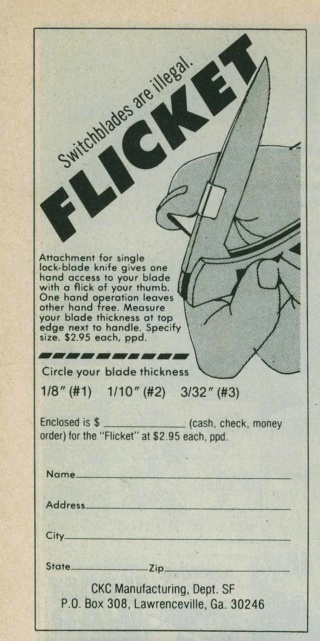
In the late 1970 a line of quality folders arrived from Seki, Japan. They were all metal, well-made, very sharp and reasonably priced. I bought one and installed a flicket. It worked fine, but there was still the problem of initial access. Then an entrepreneur in America changed the face of personal knife carry forever.
SPYDERCOSal Glesser combined an inventive mind with an ethical business concept. In 1976 he'd invented the Portable Hand, an adjustable vice designed to securely hold objects, allowing intricate manual work to be done. The multiple limbs of the "hand" resembled a spider, so Glesser named his nascent company
SpydercoHe then went on to invent the Triangle Sharpener, then, in 1981, he introduced his greatest creation; you see, he invented the hole.
To solve the problem of opening the pocket-knife Glesser introduced the dedicated opening device, by adding a hump to the back of the blade, with a thumb-hole centred within. This opener, which was a trademarked design feature, made snapping open the blade a cinch. Like many great ideas this thumb-hole was simple, and I'm sure a lot of knife makers slapped their foreheads and asked themselves why they hadn't thought of it first. Likewise, the other feature of the
Clipit, which gave the range their name, was the simple spring-metal clip bolted to the left side handle. This made access much easier than from a pouch. Seeing a picture of a Clipit you might think that the clip would get in the way of a good grip, but actually the reverse is true. The shape of the clip actually aids grip on the knife in the hand.
This first Clipit design, the
Worker, contained the three elements that define the Tactical Folding Knife [TFK]. Firstly, the knife locked open, using the proven rocker-lock method. Then the Glesser- designed opening hole and clip allowed fast access and opening. The Tactical Folder was, in my opinion, the biggest innovation in edged weapons for centuries. Spyderco patented their easy to carry folders as
Clipits. The
Worker appeared in 1981, and then it took about six years for the concept to really catch on. Spyderco brought out other models, aimed at Paramedics, police, and commercial fishermen. Other companies saw the potential and launched their own versions, until today the TFK is a massive share of the knife market.
In this article I'm going to look at some of these knives, through the prism of my experience with them. This is by no means a comprehensive survey, limited as it is, to those knives I've actually carried. Writing this piece has made me examine the reasons for each choice, and the type of training, or, tactical context, which drove each selection. There are many other great designs, but the following are my choice.
I first saw the Spyderco when I attended an advanced pistol course presented by Colonel Jeff Cooper in 1988. Jeff had used the Spyderco while hunting in Africa and enthusiastically sung it's praises.
A couple of months later while presenting a Bodyguard [BG] Course in Detroit, I was able to try out a Spyderco courtesy of Evan Marshall. I borrowed his knife while acting as a bad guy during an exercise involving protecting the VIP in his office. I was able to smuggle the all-steel Clipit through the security check, despite the trainees using a metal detector.
MARINERAfter returning to the UK, I wanted one of these useful little knives, so Terry O'Neill and I decided to visit one of the few knife shops in the country, Framar in Blackburn. After checking out the various models that Spyderco had generated since 1981, Terry decided to go for their
Police Model, while I chose the
Mariner. The models we chose reflect their intended roles. Terry was thinking principally of a self-protection knife, so chose the Police, with its prominent stabbing point. I selected the Mariner conversely, because it has no point, and looks more of a tool than a weapon. I wanted a utility knife for use on shooting ranges, or while running BG courses. The Mariner was Spyderco's second design, and the first to incorporate serrations on the edge, a feature I valued for varied cutting tasks. Spyderco had originally marketed knife-sharpening devices, and, believing that serrations were the way to go, had included a sharpener to keep such blades razor sharp. Realising that no other major designer was actually offering serrations Spyderco put them on their second model, the Mariner. Although a plain edge is best for slicing flesh, in self-protection we may have to defeat clothing or other barrier materials; and serrations do this well. I liked the non-threatening name too; Mariner is more acceptable than "Ninja death fang!" By the way, Terry later added the
Endura model, essentially a Police model with polymer grips, which he picked up in a flea market in San Francisco.
 [My first tactical folder; the Mariner]
[My first tactical folder; the Mariner]In 1991 I started attending law enforcement training conferences in America, and I noticed the widespread adoption of the Clipit knives by US police instructors. At the first IALEFI Conference I attended, there were twelve of us seated at a table during the final banquet, when a lady from another table needed a thread cutting and asked if one of us had a knife. A dozen Spydercos snapped open. The Tactical Folder had arrived.
I carried that Mariner on ranges and courses all over America, Africa and Europe for several years, and it never let me down. Although I don't carry it anymore, it's still a great knife, and is still a useful tool.

[
I used that Mariner on numerous training and operational jobs]
I still use the Mariner around the house, for opening packaging, and it has cut through yards of heavy rubber matting while upgrading impact pads for Combatives training.
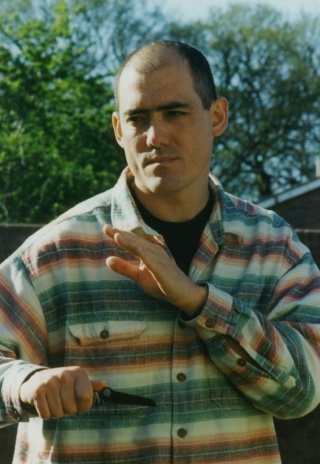 [Marcus with Mariner]
[Marcus with Mariner] While in South Africa I'd heard a story about a guy using a Spyderco to cut through a car roof. I mentioned this in
Springbok Arms gun shop during a chat about knives, and one of the customers, whose name was Ron as I recall, told me that he was the guy. An engineer for South African Airways he used his Clipit for numerous work-related cutting tasks. On his was home from the airport once Ron came upon an accident, and stabbed the Spyderco through the car roof, then ripped it open like a tin can, freeing the trapped driver. The knife was ruined afterwards, but did the job.
In another case, a chap we'll call Chris, stops his car at the "robots" [what the South African call traffic lights]. A mugger opens the rear door, gets in and takes Chris in a chokehold, levering him backwards severely. Fighting desperately, Chris manages to access his Spyderco, open it and flails blindly backwards. By sheer luck he rams the blade right into the mugger's skull, penetrating with instant, lethal, effect. I don't know the exact model, just that it was a compact Spyderco.
CQC-7Although I had purchased the Mariner as a utility knife, I started to become more interested in the knife as a self-protection weapon. I had done some training in the SE Asian blade systems, and really appreciated the value of the blade at close range, where the action is critical. Marcus Wynne had a deep background in edged-weapon systems, and continued to train, principally with Rick Faye in Minneapolis. Marcus showed me some of the moves, and I was hooked. Nick Hughes, who is truly a master of weapons, also influenced me in training for the knife.
I was considering buying a TFK to complement the training, and was scoping out the available models. I wanted a model with a decent point to allow stabbing, as well and a good slashing edge. Still debating which to choose' I made a visit to Minneapolis to conduct a training course. While there, Marcus presented me with a Benchmade CQC-7. I was overwhelmed by such generosity, as the CQC-7 was an expensive item.

Due to publicity by Richard Marcinko, in his Rogue Warrior books, the CQC-7 had become the "in" knife to own in the community. That black clip became a discreet status symbol. While I'm not big on status symbols, I loved the knife. That all black, tanto-pointed, chisel-edged design was a lethal work of art.
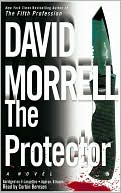 [David Morrell also featured the CQC-7 in his books, and on the cover here]
[David Morrell also featured the CQC-7 in his books, and on the cover here]There were a couple of differences between the CQC-7 and my previous Spyderco. As mentioned, the CQC has a wicked tanto-type point. The locking system is different, too. The Mariner had the "rocker lock", originally created by Harvey McBurnette, and popularised by Al Mar. The CQC-7 utilises the Walker inspired Liner Lock. Although both designs are strong and secure, the Liner Lock allows the blade to fly open more smoothly.
The CQC was one of s series of folders designed by custom maker Ernie Emerson, and used extensively by members of the US Naval Spec War community. The CQC-7 was a licensed version manufactured by Benchmade. Blending ATS-34 blade steel, G10 and Titanium for the body, this knife was a superb weapon.
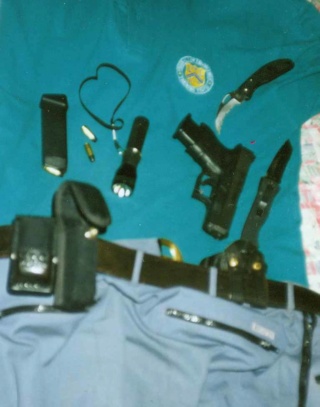 [Personal kit for this trip included a CQC-7, as well as a cheap Hawksbill]
[Personal kit for this trip included a CQC-7, as well as a cheap Hawksbill]By the way, most TFKs should be reserved for self-protective use only, and a Swiss Army Knife, or, Leatherman Tool, carried for utility tasks. However, my good friend Victor used his CQC-7 extensively on military service, and it held up well.
A useful adjunct, offered by Emerson, is a safe training version of the CQC-7. This allows draw/access training with a live, active opponent, to be done safely.
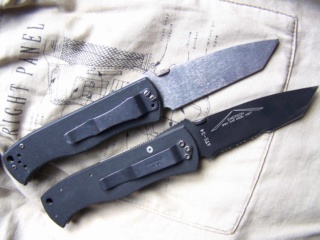 [CQC-7 with dedicated safe trainer]
[CQC-7 with dedicated safe trainer]I carried the CQC-7 for about two years, before adopting the next TFK in my progression.
SPYDERCO CIVILIANOn my regular visits to South Africa during the Nineties, browsing the gunshops, I started to notice a very radical large folder, with a wicked curved blade, like a Raptor's claw. This was the Civilian, a rather mysterious design, which at the time didn't feature in the Spyderco catalogue. In fact, the only place you saw it for open sale was in RSA; back in America it's sale tended to be aimed at the law enforcement market.
 CIVILIAN DESIGN HISTORY
CIVILIAN DESIGN HISTORYAccording to Sal Glesser
"The Civilian was designed after a long conversation with several DEA officers at a Show. The scenario was explained this way; "We have an officer working undercover in a Crack house. He can't carry a piece. He has no Martial combat skill. Please create a low profile defensive knife that he can use, if discovered, to get out of there alive. The Civilian has a patented reverse "S" blade that's intended to be used like an oversized claw. The tip is ground to an ultra-thin profile. Deeply curved and full at the belly, the VG-10 hollow-ground blade excels in slicing and is available fully SpyderEdged. Because of its distinctly specialized features it is not intended or designed for general utility or everyday use. Curved in all the right places for ergonomic use and retention of the knife, the handle is black G-10. Mounted for tip-down carry with a custom curved black clip, the knife rides deeply and unobtrusively in a pocket........ It is a very efficient defensive cutting edge. Kept sharp and not used for anything except the possibility of self defence. It could save your life. It is probably not a good idea to show it around. The appearance alone of the Civilian sometimes makes people nervous."
Although I found the Civilian interesting, it wasn't until a senior SAPS Officer, Colonel Mike, alerted me to just how effective that radical knife could be. The blade is visually intimidating. This can be a deterrent, and enable you to win without fighting. Mike, one of our course graduates, was on a Bodyguard assignment, and entered the elevator of a hotel at the car-park level. The two characters who followed him in fitted the profile of local street scum, and he went to Condition Orange. One stood facing him, and as the doors closed his partner produced a craft knife and started to open it. Mike had already palmed his Civilian, and commenced proceedings with an elbow-smash to the jaw of the closer threat, then flicked open the Spyderco. At the sight of the curved blade the knifeman dropped his blade, and almost beat it to the floor, cowering in a foetal position on top of his compadre. Mike transferred the Civilian to his left hand, drew his Glock 26, and covered the pair until the elevator reached his floor.
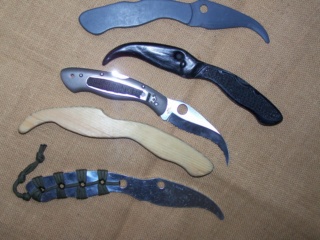 [Civilian plus various trainers
[Civilian plus various trainers]
South Africa is a high edged-weapon environment, and the visual-deterrence effect of the Civilian was appealing. Mike attended our first Combative Knife Program in Jo'burg, and used his Spyderco Civilian throughout. He showed me some of the specialised applications and I was hooked..... fortunately, not literally!
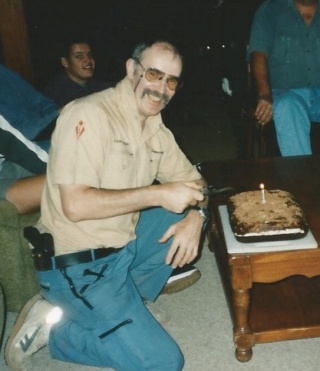 [Using my Civilian to cut the cake for my birthday]
[Using my Civilian to cut the cake for my birthday]On a subsequent visit to present the first
Weapon Retention Program for SAPS officers, I was able to pick up and view a copy of the instructional video on the Civilian, by James Keating, of Comtech. Keating had done a lot of research, and taken the Civilian methodology to a high level. The video is available
hereI took myself along to RAM, the local importers of Spydercos, and bought myself one of the aluminium-handled models. Although it was pricey, at the time it was the most expensive product offered by Spyderco, the fit and balance were well worth it to me.
CIVILIAN TECHNIQUESAs mentioned above the stated function of the Civilian was to allow a minimally trained officer to get out of a hostile situation fast. So the fundamental technique envisages the Civilian being used passively, just covering up, or, shielding, the aggressive limb will meet the blade, and will be on a curve whichever the direction of force. "Curves equal cutting". The limb will "cut itself" as it attacks
 [Slackbladder demonstrating the "cut loose" concept]
[Slackbladder demonstrating the "cut loose" concept]With a degree of training the weapon can be used actively, to "defang", as the FMA guys call it, that complex curve conforms to the human arm, again massive trauma with little skill.
To illustrate that "defanging" capability, a case from RSA: Les Van, former Special Forces soldier who attended our TFK course in Nov 98, is entering Eastgate shopping mall. In his own account he was alert crossing the car park, but dropped into Condition White inside. He was getting the shopping list out of his pocket and looking down when he bumped into "gorilla", at least 6' 5" and heavy. Although Les apologised the guy turned and palm-thrust him in the face, knocking him right back into a bench (which prevented Les falling). The gorilla, rushed in shouting. Les accessed his Civilian and slashed the reaching arm. The guy froze, and screamed so loud that it even shocked Les. Blood spurted up over the cinema posters.
Security staff arrived and seeing Les with a knife and the guy bleeding, arrested the guy! Shop staff then laid charges against the guy, who had been extorting money and molesting waitresses.
When SAPS arrived Les showed them his other knife, a Spyderco Rescue, rather than the aggressive Civilian. He was not charged.
Researching the technique of the Civilian across my network of knife-savvy contacts I found that most were negative about it. Hardly, surprising, considering that most, living in America, had little exposure to the weapon. For those who want to go beyond the fundamentals, to acquire more expert skill with the Civilian I recommend the works of Jim Keating. As Sal Glesser noted
"The knife was designed with the non trained person in mind. James [Keating] is certainly well respected and knows what he is speaking about. I imagine it would be easier to cut one-self with the Civilian more easily than a more conventional design if one were not paying attention. Certainly James has come up with far more uses for this defensive tool, than was thought of in the original design. This is because of his greater knowledge and skill in this area. Careful training would probably not be a bad idea with reference to this model, but the original intention for the shape was just slash anything that comes near you and hold on to the piece. The shape of the blade would do the rest."
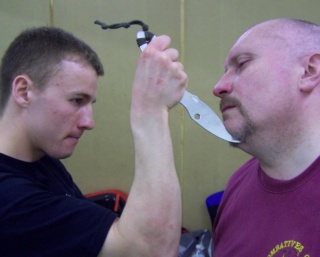 [Brian shows a ripping technique on Larry]
[Brian shows a ripping technique on Larry]Because the point of this knife is not in line with the handle, conventional stabbing thrusts are denied. Instead, a specialised set of thrusts are available. As Sal Glesser explains:
"The tip is angled to be at the optimum angle for the point of the blade to pierce at the "point of entry" and continue piercing. This done with an arc type motion rather than an extending "stab type" motion. The area behind the tip is designed to create as little "hang up" as is possible. "in & out" leaving a slash type cut. The large belly behind the tip is a back up of the cut, or can be used to create a slash as well. Far more effective for a defensive move than on offensive one...... When the tip enters, due to the arc, it's a thrust action with a follow through, rather than a thrust action with a pull back. Essentially a poke."Keating teaches a number of advanced insertions and extractions using the tip. These are precision actions, requiring trained skill, but once learned make the Civilian even more formidable.
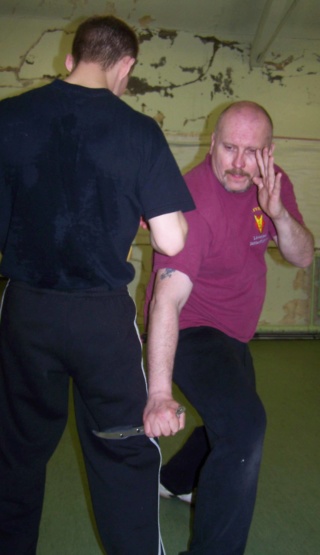 [Larry shows a hooking technique
[Larry shows a hooking technique]
It is important to remember that Mr Glesser designed the Civilian as a weapon right from the start. The Civilian was at the time, in fact the only knife classed by Spyderco as a "weapon", all other models are marketed as "tools". Despite this we still hear complaints that the Civilian is unsuitable for opening cans, carving wood, digging up roots etc. It is what it is. It's a weapon not a screwdriver, pry bar, or, chisel. Carry it as a weapon and use it only for protective purposes and it will work fine. I've never heard of a Civilian being damaged on a human target. Carry a Leatherman, Swiss Army, or, the ingenious SpyderWrench for utility tasks.
Various commentators have speculated about the tip of the Civilian being fragile. Regarding fragility, well this case demonstrates that the Civilian tip does the job....
A guy we'll call Dan, has picked up company payroll from bank. He is carrying his Civilian in his hand, but not as a tactical precaution, more like you carry your keys and twirl them. He is attacked by two gunmen. The first grabs his arm. He opens the Civilian and goes in with a lowline ripping strike. The point enters the inguinal area, rips right through and cuts his belt off from the inside! Man down, instant fatality. Dan slashes at the second robber as he legs it... just missing his back.
No getting tangled in clothing, no bending or breaking. I've have several Civilian cases on file, and that blade just rips free through flesh, clothing, leather, whatever, every time.
The Civilian fitted very well with the type of edged-weapon training I was doing at the time. The large opening hole made getting the knife into action very positive. The only feature I had disliked about the CQC-7 was the disk opener, mounted atop the blade. Since Spyderco had patented the thumb-hole other manufacturers had found it necessary to devise alternative methods. Unfortunately, in my opinion, the disc was the least satisfactory. It was especially awkward to open if forced to access the knife with the left hand, a scenario possible in standing-grappling scenarios. I'd been used to the thumb-hole on my Mariner, and returning to it with the Civilian was a bonus.
I was really enthused with the Civilian, and, as a result, wrote my first knife article "The Secret Spyderco", which was published in the USA by SWAT Magazine, and in Europe by Fire! Magazine.
It was during this time that I started looking at the concept, espoused by several knowledgeable trainers, of carrying a backup knife.
BACKUP BLADEThere are a couple of reasons to carry a second self-protection knife. If you are pinned down in a grappling situation, you may be laying on top of your knife, with the full weight of two bodies preventing you from accessing it. A second blade carried on the other side, can be the solution. Another idea is to carry a deep-cover knife as a last ditch weapon, in case you are taken prisoner and disarmed.
I'd seen a knife in the Spyderco catalogue, and in the display cases at Ram, the importers, and Sharp Edge, my favourite knife store, in RSA, which caught my interest. A Hawksbill, curved blade design, in many ways the
Harpy can be called the Civilian's feisty little sister.
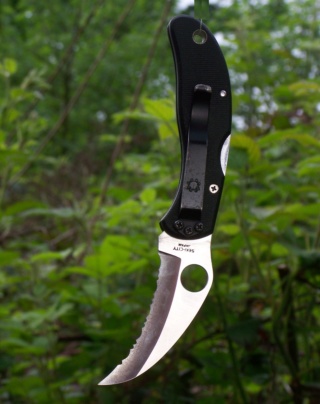
According to Spyderco,,,,, the claw of the Harpy eagle the C08 is shaped for controlled pulling cuts. The hawksbill blade shape originated in the marine/fishing industry where severing rope, line, webbing and netting is done at arm's length quickly and efficiently. The curving arc holds what you're cutting against the sharpened edge keeping it from slipping off the tip.
It may have been created for fisherman, but that Harpy seemed a wickedly effective self-protection design. A leading US knife company was offering the last batch of g-10 handled Harpy's at a knockdown price, and I sent off for one. When it arrived I was delighted. The Harpy blade was viciously sharp; the G-10 handle warm and secure, and the knife locked up like a safe.
CARRY OPTIONSClipping a TFK to your pocket or waistband is fine for most urban applications. However, there are situations involving physical activity and exertion, such as SWAT raids, white-water rafting, airborne operations, that tax the security of the clip. In RSA I lost my CQC-7 during helicopter operations with the Internal Stability Unit. Fortunately, the stick-member behind me found it and gave it back. A friend on the British Military Close Protection Team wasn't so lucky. He lost his Spyderco
Wayne Goddard during heli-ops, and it was never seen again. Sure, you can increase security if you bury the knife beneath layers of clothing, or, clip it into a flap pocket, but these measures compromise the fast access which is the reason we carry a TFK. Mike Sastre, a keen white-water sportsman has come up with a solution. He devised a neck sheath for the Harpy, which offers total security, together with fast access and presentation.

The neck sheath carries the folded knife, either under clothing for discretion, or overtly in rural/sporting situations. You reach up and pinch thumb/forefinger through the thumb-hole, tug downwards, and as the knife comes free snap the blade open in the popular "spydie-drop" action. Very fast and positive. The Kydex sheath is moulded precisely for a good friction fit. The knife will never be lost from this sheath.
Mike now makes his sheaths for most popular TFKs, and also offers them in Concealex, a carbon fibre even better for sheaths than Kydex.Contact him at
River City Sheaths
[
Police officers can clip the TFK to their body armour. By leaving a shirt button undone, access can be surprisingly fast]
The hawksbill can be a fight winner, as our next case illustrates: A computer engineer gets in to a lift [elevator] carrying two briefcases. He crouches slightly to put them down in corner, and is shoulder charged into corner by two knife-wielding robbers, who demand his wallet. He can't see and his arms are pinned. He manages to access his Spyderco Harpy and "cuts loose" slashing the grabbing arm; then blindly slashes back, getting number two across the face. The fight is on! He continues "slicing & dicing " until both are down.
Asked afterwards what was the most difficult part. He reflected, "keeping my balance with all the blood on the floor... I kept slipping and had to grab the rail as I slashed"
THE NIKITA ASPECTAt CQB Services we train many female operators, and the Harpy seems ideal for them. Lightweight and short it fits the average female hand. World ranked instructor Graciellas Casillas, has made the point that the female fears being disarmed. A short, hawksbill knife presents nothing for an assailant to grasp for leverage... it's all blade. Now Graciellas prefers her own LADYHAWK design, but the concept applies well to the Harpy.
The hawksbill design is ideal for anti-grappling, where you may need to insert the blade between your body/ limbs and the attackers. This is especially critical in ground defence, which female self-protection must emphasise. The Harpy comes with another Spyderco innovation, the serrations. These "capture" and control the attacking limb, again important for females who may lack the strength to do this unarmed.
We introduced a knife module into the Nikita Project, the specialised course, designed by Marcus Wynne to accelerate the training of female personnel. I always showed the Harpy to the attendees
MOVING ONÂ I carried the Civilian/Harpy package for several years, whenever I was in a place where it was legally permitted. Most of the work I was doing was in RSA, where, as mentioned the visual deterrence factor was a plus.
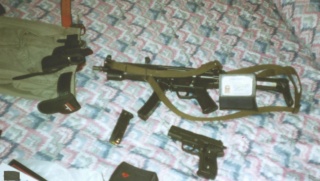 [While training a SWAT Team, I used this kit. You can just make out the Civilian on the belt]
[While training a SWAT Team, I used this kit. You can just make out the Civilian on the belt]Showing the knife to police officers in other countries, however, often produced a very negative reaction. Even SWAT instructors, who were happy to deploy with fearsome 12-guage shotguns, winced at the sight of the Civilian. When I told them it was originally designed for law-enforcement use, one instructor quipped that the only was a police department would let him carry that knife was if "Dirty Harry was made Chief of Police, and Hannibal Lecter elected Mayor!" Now, if seasoned cops look askance at the Civilian, what do you think the reaction of the average citizen will be? And those citizens are the jury pool if you ever end up in court after having to use severe force. As much as I loved the Civilian, it wasn't the ideal weapon for "problem two" As defined by Jeff Cooper, "problem one" is winning the fight. Then "problem two" involves winning the subsequent legal process. If you have been forced to defend yourself against unprovoked criminal attack it shouldn't matter what tool you used.... but unfortunately, in the real world, it does.
Another factor was that in my ongoing research I was fast reaching the conclusion that slashes were not the best fight-finisher with a compact knife. To stop an amped-up, committed attacker you need thrusts penetrating the body cavity, inducing involuntary collapse.
To illustrate how slashes are not always the answer, another case from RSA: Anthony, a graduate of our VIP Protection Course, and a professional self-protection instructor is leaving the gym one night. As he walks across the car park he has his Glock in a moon-bag, looped over his shoulder. Out of the shadows he is pack-attacked by three muggers. He quickly draws his Spyderco Harpy and goes to work slashing the thugs as they try to grab him. After a bit Anthony pauses and tells them "I'm cutting you, look you're bleeding" The would-be muggers check themselves, realise they are indeed in a knife fight, and hastily run off.
At the time I was meeting regularly with Terry Haglund, now sadly deceased, who was an authority on all aspects of edged weapons. Terry had particularly researched the WW-2 methods of knife combat, and he readily shared his material with me. I remembered, too, the stuff that Nick Hughes had shown me when we attended a training conference together, in Florida, in 1993. That military methodology, based on his Foreign Legion training was, like the WW-2 syllabus, aggressive, simple, and based more on stabbing than slashing. Also, it shared commonality with the type of unarmed combatives I favoured, so the "seamless transition" required for CQB was more likely.
Brilliant as the Civilian was, I started considering another design, one suited to snap-cuts, direct-stabs and hook-thrusts of the wartime-oriented methods. I had attended a course with Bob Kasper of the GHCA, whose
Kni-com methods were a blend of WW-2 [mainly Styers] concepts, with current street-based strategies. Besides teaching and writing about knives, Bob was an accomplished designer. So that was the direction I next looked.
KASPER FIGHTING FOLDEREvery knife instructor has a collection of fighting knives, and every instructor has his own ideas of the optimum blend of features that make his ideal weapon. Some years ago Bob Kasper released his concept, called the Kasper
Bulldog. Manufactured by Al Polkowski this was a 6" double-edge fixed-blade fighter. A shortened 5" version, the
Pug was then produced. Finally, at the request of a US Department of Defence Special Unit, a 4" single-edge version, the
Companion was designed. With the popularity of the Tactical Folding Knife (TFK) market Mr Kasper had Pat Crawford transmute the Companion into a folder.
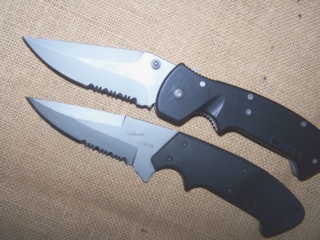
[
Kasper Folder and fixed blade]
Bob described his design...
"The Kasper Fighting Folder was designed for just that... fighting. It is a pure, defensive, tactical folder. The design is almost an exact copy of my four-inch fixed-blade Fighter made by Al Polkowski. The KFF incorporates all the features of my fixed-blade version, with those of a well-designed fighting folder.
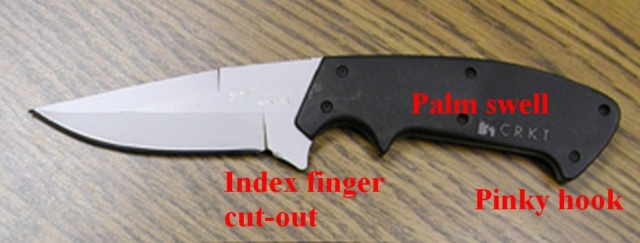
The handle has a large index finger groove for indexing, and also acts as an ample forward lower guard. The pommel is a drop design, which acts as an indexing point for the pinkie, and aids in locking the knife to the hand. No matter whether you're slashing, thrusting, or, retracting, this knife will not move in your hand." [Index finger cut-out and recessed liner-lock]
[Index finger cut-out and recessed liner-lock]The forward top of the handle is arched and aggressively serrated for 1.25". This gives it a positive thumb-rest for a Sabre grip, which is needed to execute powerful Snap-cuts.
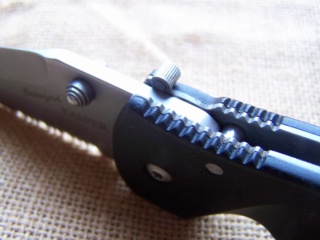 [Serrated thumb-ramp. Note the LAWKS safety]
[Serrated thumb-ramp. Note the LAWKS safety]The KFF's blade is a double-grind, clip-point design. It has a slight belly, and sweeps smoothly back to the ricasso, to create 3.75" of cutting edge. It has a 3.25" secondary progressive false-edge. Total blade length from handle to tip is slightly less than four inches; staying under the legal limit.
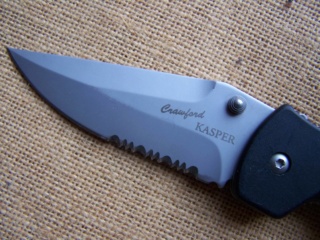 [The "Persian profile" blade]
[The "Persian profile" blade]Some of the fighting folder features include a recessed liner lock, to eliminate accidental disengagement; a double thumb-stud for strong or weak-hand opening; an extreme forward-mounted pocket clip for unobtrusiveness; and a large scallop on the left scale, which acts as an index point for drawing, as a thumb-ramp for easy access to the opening device, and as an extra index-finger groove for positive gripping power. And, most importantly, it has a matching, fixed blade, twin brother."
This was well received, but as a $350 custom item it was beyond the pockets of many potential users. In 1999 Columbia River Knife and Tool company (CRKT) reached agreement to market a factory produced version, and this is the knife under discussion. I bought mine in May 200, in Sharp Edge, Sandton, RSA.
One design feature added by CRKT is the safety lock. Termed the "Lane-Walker Knife Safety" I was lukewarm about this device at first, but have come to appreciate it. In use it is virtually automatic... as you assume the Sabre grip the catch slides locked.
By the way, Bob designed the serrated thumb-rest specifically to accommodate the Sabre-grip, as, at the time, he was heavily favouring this Styers-influenced technique. However, after engaging in a lengthy program of intensive, reality-based knife training, Bob found certain weaknesses with the Sabre grip. He went into print and published his new conclusions, reversing his previous view. This is the mark of a top instructor, who puts tactical truth before personal ego. Although, the KFF was suited to the Sabre grip this in no way limits the use of other grips. The standard, or, "hammer" grip works fine, as does the Reverse grip
.
 [Bob Kasper with Den
[Bob Kasper with Den]
All in all, this knife was designed for fighting by a man who knows the subject inside out. Sadly, Bob died a while back. He was a gentleman and a brilliant instructor. He is truly missed in the tactical community.
 [Kasper folder and fixed blade, with various trainers]SOUTHERN COMFORT
[Kasper folder and fixed blade, with various trainers]SOUTHERN COMFORT
Early in the 21st Century I was delighted to be one of a small group of guys included in the distribution list for a private video tape made by the enigmatic SouthNarc. In it this officer, who because of his undercover narcotics work has to remain anonymous, shared several of his close-combat concepts, including the Reverse-grip knife methods, based on the Perkiti-tersia "edge-in" pikal system. I found it fascinating, and like all good stuff, simple and direct. SouthNarc has now released a DVD on the topic available
here [Southnarc demonstrating a pikal technique on Slacky]
[Southnarc demonstrating a pikal technique on Slacky]Knives suitable for pikal are rather rare, but S'Narc had already written a detailed evaluation of such a weapon, on Don Rearics very informative website [url="http://www.donrearic.com/southerncomfort.html]here[/url]. I don't really know what Kershaw had in mind with the Talon. That blade is obviously designed for anti-personnel work, so why put a bottle-opener on it? And the grip, ideal for pikal, is, by definition, unsuited to conventional holding. Whatever, all that matters is that the Talon can be modified into the very practical Southern Comfort.
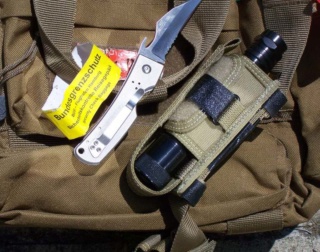
I obtained one of this now rare weapons, and decided that it would do very well as my left-hand access knife. Carrying clipped to the left pants pocket the Southern Comfort draws to a reverse-grip pikal position. Because the bottle opener catches the pocket, the knife opens "automatically" on the draw, without having to actuate an affirmative opening device. In my opinion this knife opens even easier than the original Wave.
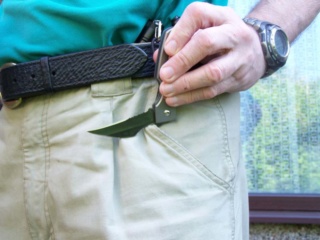
[
The draw from the left pocket]LESSONS FROM TRAININGThe above progression through the various models came mainly from the evolution of my own training. I continued researching, discussing, exchanging ideas, and trying out methods. Such training covers several phases.
Firstly the Fundamentals form the basis for knife-in-hand fighting, whether using a folder, or, a fixed blade. Strike angles, grips, footwork are all blended into a workable package. During this phases we should experience using live blades on target-simulants, to feel the impact and resistance when stabbing or slashing flesh.

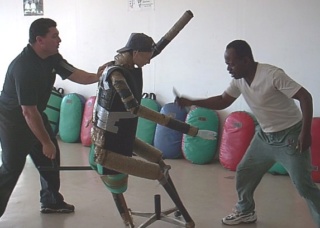
The next phase involves what I term "Task related training" especially working on the specifics related to the particular folder you favour, and where you carry it.
Next comes
Conditions, putting the techniques from the previous phases into play under various real-world conditions, such as cold, numb fingers, or, slick sweaty/bloody fingers. Work on access while being pinned down on your back, sides or front. Work from restricted and unconventional positions. Do some access drills after arduous physical activity, when you're a sweaty mess with muscles engorged with lactic.
Finally, test all of this under spontaneous scenario training against active, human aggressors, obviously using safe training knives.
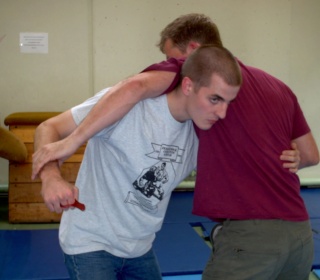
Having done quite a bit of this type of training I came to the conclusion that the Tactical Folder is not the best bet to defend your life. Under intense psychogenic stress the first place affected as the neural surge and adrenal dump prepare the organism for the life and death battle, is the fingers. With a folder you'll be trying to dig the weapon out....with the fingers. You'll be trying to flick open the blade....with the fingers. Finally you'll be trying to then shift to a more secure grip....with the fingers.
These days my chosen self-protection knives are all fixed blades. The Kasper Companion, a Push Dagger, or, a Hideaway Knife.
The tactical folders discussed above are all great knives. There are many other superb TFKs, and I own a substantial collection, but the ones above are those I selected to look after me in various interesting places, and, more than once, they provided peace of mind in a tense situation. I still own them, and loan them to guys on courses. I had a great time training with them, but in my opinion, the folder has evolved into a modern pocket knife. There is still a place for an easily carried, handily accessed knife for those workplace, garden, household and general tasks.In the cases cited above, the good-guys managed to use their TFKs with sucess under intense stress. However, we don't have a library of cases where guys failed to get their folders into action, but there is no doubt this has happened. In training and planning for our self protection we must play the percentages, and folders are not the primary choice for a weapon to be deployed under conditions of intense pressure, at extreme close range. In my opinion, as far as self-protection is concerned, the arc of the TFK is over.
THANKS TOMy late friends Terry Haglund and Bob Kasper, RIP
Joyce Laituri at Spyderco
Marcus Wynne, Mika Soderman, Mike Henning, Nick Hughes, SouthNarc, Slacky, Larry Blundell, Brian Lightbody.
COPYRIGHT 2008: (c) D. MARTIN
